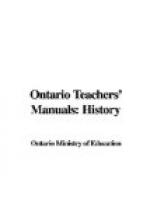General Description.—As each of the above methods has its strong and its weak points, we should attempt to combine the strong points into one method, varied to keep pace with the mental development of the pupil, and thus secure the best results. The general outline of such a combination may be given as follows: The “oral story” is to be used in the junior classes, with “development” problems presented where helpful; in Form III the pupils should be introduced to the text-book (The History Reader for Form III), besides being taught by the oral method; in Form IV, the oral method is still to be the chief means used by the teacher, who will now, however, pay more attention to the arrangement of the matter (for example, in topical outlines), to accustom the pupils to grasp more thoroughly the relations of cause and effect in history. The topics of history will also be taken up more exhaustively than in the junior classes, and the pupils must have more practice in acquiring knowledge from the text-books.
DETAILS OF METHOD
FORMS I, II
In Forms I and II, the pupils are accustomed to the oral reproduction of stories told by the teacher. In these should be included a good many historical stories, such as those suggested in the Course of Study in History for these Forms; they will serve the usual purposes of oral reproduction work for composition and literature, and will be, besides, a good foundation for the study of history in the higher forms. (For objects of the Story stage, see p. 16.)
The oral presentation of a story or description of an event requires a certain degree of skill on the part of a teacher—skill in story-telling, in grasping the important parts of the story or description, in knowing what details to omit as well as what to narrate, in explaining the story in a way that will make it real to the pupils, in preparing pictures and sketches to illustrate the different parts, and in questioning so that the minds of the pupils will be active as well as receptive. The care and time necessary to secure this skill will be well repaid by the interest aroused in history, by the appreciation of the thoughts thus presented, and by the lasting impressions conveyed. Simple, clear language should be employed, not necessarily small words, but words whose meaning is made clear by the context or illustration. (For material for these Forms, see Bibliography, C, p. 132.)
When the whole story is told, revision may be made by having the pupils reproduce it after suitable questioning, either immediately or at some future time. Exercises in reproduction may also be given, for either seat work or class work, in constructive or art work; for example, after the story of the North American Indians, the pupils may be asked to construct a wigwam, a canoe, a bow and arrow, or to make pictures of Indians, of their houses, of their dress, etc.




